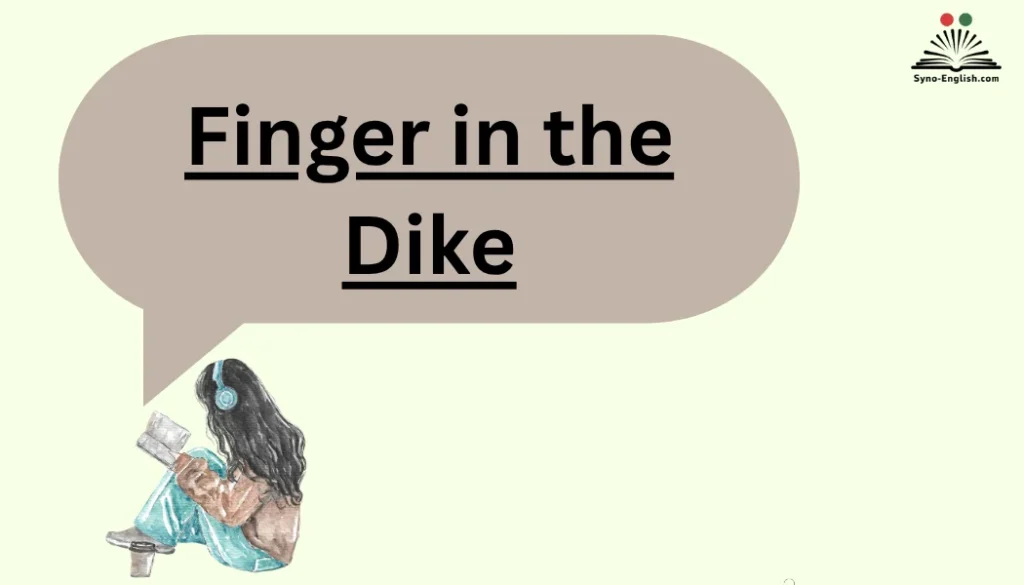The idiom “Finger in the Dike – Meaning, Origins” paints a vivid mental image of a lone boy pressing his finger into a leak in a dike to stop water from flooding a town. I first heard it as a child, and its simplicity and moral stayed with me. It’s about how a single, small act of courage can protect many lives when done at the right time.
Over the years, I’ve seen this idiom become shorthand for tackling a problem before it spirals into a disaster. Whether it’s managingwork, fixingrelationships, or handlingdailychallenges, the message remains clear: addressingminorissues early avoids bigger consequences. Like the boy with his finger in the dike, we must act quickly when cracks appear before things overflow
Understanding the Idiom: What It Means and How It’s Used
When someone says they’re putting a finger in the dike, they usually mean they’re doing a quick fix to prevent a much bigger problem. The metaphor suggests:
- Acting early on a small leak
- Preventing escalation
- Holding back disaster through vigilance
You’ll see it in contexts such as:
- Business: A manager addresses a budget leak before it becomes a crisis
- Politics: Passing a stopgap law while negotiating a major reform
- Everyday life: Fixing a small plumbing leak to avoid water damage
Variations & Related Phrases
- Plugging the hole
- Band-aid solution (though that often implies a temporary fix)
- Stopgap measure
- Temporary patch
These are not exact synonyms, but they often appear in similar contexts.
Because the image is so striking, the idiom stays memorable. Still, its literal feasibility is suspect, as we’ll see later.
Origins of the Tale Behind the Idiom
The Story That Sparked It
The tale of a little Dutch boy placing his finger in a dike comes from Mary Mapes Dodge’s 1865 novel Hans Brinker, or The Silver Skates. In one chapter (not originally Dutch folklore), Dodge describes a boy who kept water out by placing his finger in a leak overnight.
Over decades, that narrative merged with Dutch identity in popular imagination—even though it wasn’t native.
About Mary Mapes Dodge
- Born in 1831, died 1905
- She edited St. Nicholas Magazine for children
- Hans Brinker remains her best known work She wove Dutch scenery, canal life, skating culture, and moral lessons into her book. The “little boy at the dike” tale was one of several vignettes.
Fact or Fiction?
- There is no historical record of a boy named Hans (or Hansje) Brinker who saved a town by plugging a dike.
- Dutch scholars observe that Dutch folklore contains no such legend.
- The merged identity—Hans Brinker = the boy with the finger—is a later conflation, not in Dodge’s original.
So while the tale feels rooted in Dutch water culture, it’s essentially an American invention with borrowed colors.
The Reality: Dike Mechanics and Flood Defense
To understand why the idiom resonates (even if it’s not physically accurate), we need to look at real dikes and how they can fail.
How Dikes Work
A dike (or “dyke”) is an earthen embankment built to keep water out. Key components:
- Core material: often clay or compacted soil
- Faces/slopes: sea side and land side slopes to distribute pressure
- Crest: the top of the dike
- Revetment/protection: stones, vegetation, concrete or sheet piling to resist erosion
The goal: resist water pressure, waves, seepage, and overtopping.
How Failures Occur
Historical analysis reveals the main mechanisms:
- Wave overtopping: water flows over the crest, saturating and weakening the landward side. That leads to sliding or collapse internally.Erosion of slopes or crest: especially on the inner slope, or due to animals or human interference.
- Seepage and piping: water flows internally, creating channels that undermine structural integrity.
- Ice drift or floating debris impact: especially in colder climates.Foundation instability or saturation: if the ground beneath gives way or becomes soggy.
Over centuries, the Netherlands has logged 1,735 dike failures between 1134 and 2006. Here’s a summary:
| Failure Mechanism | Description & Role |
| Overtopping & sliding | Waves flow over crest → saturates interior → collapse |
| Inner-slope erosion | Weakening from below or behind the dike |
| Seepage/piping | Water carving hidden tunnels inside structure |
| Ice drift / debris impact | External physical damage to the structure |
| Unstable foundation | Soft soil or saturation undermines support |
Because of these complexities, one finger is never enough to stop a leak once it becomes significant.
Historical Floods & Dutch Water Control
Before 1953 there were many floods that shaped Dutch water engineering. Let’s highlight a few and trace how the country responded.
Significant Flood Events
- Over centuries, storm surges, war, neglect, and shifting land have battered the Dutch coast.
- The All Saints’ Flood (1570) was catastrophic in its era.
- In the 19th and early 20th centuries, repeated surges breached dikes, prompting incremental improvements.
- Many failures occurred from the landward side (via seepage) rather than just sea assault.
Even with maintenance, financial constraints or wars delayed upgrades—making many dikes vulnerable.
Catastrophic Night: The 1953 North Sea Flood
This event serves as a powerful real-world parallel to the metaphorical idiom.
What Happened?
Between January 31 and February 1, 1953, a storm surge collided with a high spring tide, pushing sea levels far beyond what coastal defenses could hold. Over 60 miles (100 km) of seawalls failed.
- More than 150 dike breaches occurred in sea dikes.
- Around 136,500 to 162,000 hectares were inundated. Approximately 1,836 people died.
- 47,300 buildings were damaged; thousands of livestock were lost.70,000 people were evacuated.
It left deep scars—not just physical, but social and psychological.
Real Heroism: Ships in the Breach
When dikes failed near Nieuwerkerk aan den IJssel, a segment of the Schielands Hoge Zeedijk threatened to collapse.
Volunteers used a ship, Twee Gebroeders, to plug the breach. The plan: manoeuver the boat into the gap, wedge it in, and slow the flood’s advance until sandbags and earth could be filled in
Skipper Evergroen steered the vessel at the right moment. The gap was held long enough that the breach didn’t widen disastrously.This act mirrors the metaphor—holding back disaster while more robust repairs take place.
Aftermath & Response
- The Delta Commission was founded within weeks to reimagine flood defense.
- Delta Works, a massive system of dams, barriers, and dikes, emerged over subsequent decades.
- Many of the breach holes were repaired with caissons (huge prefabricated concrete boxes) to plug gaps.
A museum—Watersnoodmuseum—stands today in Ouwerkerk, housed in four caissons used to close the last dike gap.
How the Idiom Migrated into Language
First Metaphoric Uses
Soon after the story of the little Dutch boy circulated in America, writers adopted the image in metaphorical contexts. The idea was irresistible: one finger, one leak, one crisis avoided.
By the early 20th century, “finger in the dike” had become a figurative phrase in English newspapers and speeches.
Spread and Popularity
- In political commentary, it’s used to describe temporary policy fixes.
- Business writers use it to talk about addressing “small leaks in cash flow.”
- In personal life, people might say they’re putting a finger in the dike when managing a tough but manageable issue.
Because the metaphor is visual and emotional, it tends to stick in people’s minds.
Cultural Impact & Misconceptions
The Myth’s Paradox with Dutch Reality
Many Dutch people never heard the story until tourists told them. That’s because it originates not in Dutch folklore, but in an American children’s novel. Yet the Netherlands now pays homage:
- A statue at Spaarndam near Haarlem commemorates the “little boy and his finger.”
- Tourists often ask where the boy put his finger; locals generally smile.
- The phrase is sometimes understood abroad as originally Dutch, which is misleading.
Lessons & Warnings
- The metaphor suggests that small interventions always suffice—but real systems rarely allow that.
- Overuse of stopgap fixes can mask deeper problems that demand structural change.
- Still, the image remains powerful: vigilance, moral duty, and readiness to act early.
Modern Relevance & Takeaways
Risk Management & Crisis Control
In business or government, placing a finger in the dike doesn’t scale. But knowing when to act early makes all the difference. Address minor vulnerabilities before they explode.
Engineering & Climate Change
The Dutch continue to confront rising sea levels, stronger storms, and climate shifts. The floods of 1953 are not just history—they’re a reminder that disaster can return if vigilance lapses.
They invest heavily in adaptive infrastructure, nature-based defenses, real-time monitoring, and community awareness.
Cultural Memory & Metaphor Power
The phrase reminds us that legends carry lessons even if they’re fictional. The power lies not only in literal truth, but in symbolic resonance.
Summary & Final Thoughts
The idiom finger in the dike endures because it compresses drama, urgency, and metaphor into a simple image. Though the tale is fictional and literal execution is impractical, its core message—nipping trouble early—resonates across time.
We see it in crisis management, engineering, politics, and everyday life. We also see the contrast between metaphor and reality: real dike systems require complex engineering, monitoring, and adaptation.
The next time someone says they’re putting a finger in the dike, you’ll know not just what they mean—but how that phrase traveled from an American novel into global language, buoyed by Dutch landscapes, climate lessons, and human imagination.
If you like, I can provide a version optimized for SEO, or generate a shorter summary or infographic to accompany this. Would you prefer that next?
Conclusion
The story behind Finger in the Dike – Meaning, Origins continues to remind us that even the smallest actions can prevent great disasters. The idiom captures the importance of early intervention and personal responsibility. Just as the lone boy stopped water from flooding his town with his finger, we too can stop problems from spiraling when we act with courage and awareness. In both personal and professional life, a small step taken at the right time can change the outcome entirely.
This timeless lesson applies across every aspect of life—relationships, careers, or even communities. When we recognize an issue and take preventive action before it grows, we embody the same moral the story teaches. The idiom is more than a tale; it’s a symbol of wisdom, presence of mind, and determination to tackle life’s problems early. Acting swiftly doesn’t just stop challenges from overflowing; it also builds trust, resilience, and integrity. The essence of this phrase lies in the power of small deeds that protect greater good.
FAQs
What does “Finger in the Dike” mean?
It means stopping a small problem before it becomes a major disaster by taking quick and responsible action.
Where did the idiom originate?
The idiom comes from a Dutch legend about a young boy who saved his town by plugging a leaking dike with his finger.
What moral does the story teach?
It teaches courage, responsibility, and the power of small actions in preventing larger problems.
How is it used in modern language?
People use it as a metaphor for dealing with issues early before they escalate.
Why is the idiom still relevant today?
Because it applies to all aspects of life—personal, social, and professional—where prevention matters.
Is the story of the boy true?
It’s more of a legend popularized through literature, especially in “Hans Brinker, or The Silver Skates.”
What does the dike represent symbolically?
The dike symbolizes barriers that protect us from overwhelming problems or disasters.
What does the finger symbolize?
The finger represents personal responsibility, quick thinking, and bravery in urgent moments.
How can this idiom be applied in daily life?
By addressing small conflicts, mistakes, or tasks before they turn into unmanageable issues.
What is the key takeaway from this idiom?
That small, timely actions backed by awareness and courage can prevent major consequences.

Emma Brooke is a passionate English educator, writer, and language enthusiast with over a decade of experience helping learners master the nuances of the English language. At SynoEnglish, she blends practical grammar advice with real-world communication tips to make English easier, clearer, and more enjoyable for readers of all levels.



